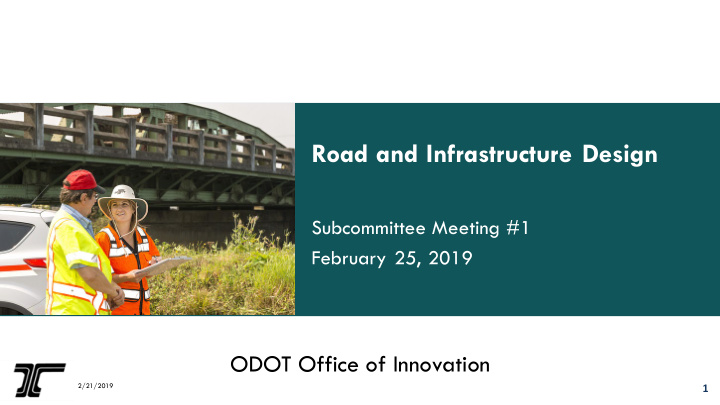



Road and Infrastructure Design Subcommittee Meeting #1 February 25, 2019 ODOT Office of Innovation 2/21/2019 1
Welcome and Introductions 2/21/2019 2
Review of Scoping Results 2/21/2019 3
Principles Infrastructure Funding • How will transportation infrastructure funding need to • Ensure that automated vehicles can safely shift? interact with roadway infrastructure • Who will pay for transportation infrastructure? How will • Ensure safety of vulnerable road users, including revenues decrease? pedestrians, bicyclists, motorcyclists, and others Electric Vehicles AV/CV Changes to Infrastructure • AV environmental impacts • Infrastructure needs of both automated and • Shared, autonomous, electric vehicle needs, including conventional vehicles during transition investment in EV charging • Maintenance requirements and recognition • How to design infrastructure for EVs and vehicles that use other fuel sources? • Dedicated bandwidth for V2V, V2X Repurposing Parking and ROW • High speed data communications infrastructure • Parking – AV driven changes to design and requirements • Security and control of interconnected • Repurpose street parking, etc., for storm water infrastructure management • State role in standardization of signs, design, etc. • Optimize capacity within the existing right of way (lane • Road design impact to insurance costs width and vehicle spacing) • Need for statewide shared mobility rules and • Consider right of way increases on all highways infrastructure • Address all design issues in the right of way • Opportunity to solve congestion 2/21/2019 4
State and Federal Roles in Infrastructure Design 2/21/2019 5
State and Federal Roles in Infrastructure Design • Many elements of infrastructure design standardized by federal government, AASHTO • Manual on Uniform Traffic Control Devices (MUTCD) governs signage, signals, markings • AASHTO Green Book governs geometric design of roadway • National guidance allows some flexibility in how states implement 2/21/2019 6
Manual on Uniform Traffic Control Devices • MUTCD governs design of signs, signals, and pavement markings • Administered by Federal Highway Administration (FHWA); developed with input from a national committee • “3.0 AV Guidance” announced that FHWA will update 2009 MUTCD to address AVs 2/21/2019 7
AASHTO Green Book • American Association of State Highway Transportation Officials (AASHTO) publishes Green Book • Green Book sets standards for road geometry – Local roads and streets – Collector roads and streets – Rural and urban arterials – Freeways – Intersections – Grade separations and interchanges 2/21/2019 8
State Role in Infrastructure Design • ODOT is responsible for state infrastructure: – Construction and maintenance of infrastructure – Road striping and signage – Operating signal systems on state infrastructure and in some local jurisdictions – Intelligent transportation systems • Local jurisdictions are responsible for administering local infrastructure • In the future, state and local jurisdictions could be responsible for connected vehicle roadside infrastructure 2/21/2019 9
Background on National Efforts 2/21/2019 10
Updates to the MUTCD • “3.0 AV Guidance” announced that FHWA will update 2009 MUTCD to address automated vehicles • Proposed changes expected to be released for comment Spring 2019 • National Committee met in January, meets again in June to discuss updates 2/21/2019 11
SAE: Infrastructure Needs Related to Automated Driving • Society of Automotive Engineers (SAE) convening committee on AV infrastructure needs • Serves as forum for manufacturers / infrastructure operators to exchange information • Will identify highway infrastructure elements to benefit all levels of AVs • Kick-off call held 2/21, additional meetings scheduled through March 2/21/2019 12
NCHRP 03-127: Cybersecurity of Traffic Management Systems • National Cooperative Highway Research Project (NCHRP) has several projects related to connected/automated vehicles • Project 03-127 seeks to develop guidance for state and local transportation agencies to mitigate cyber attacks on traffic systems • Literature review already available, project expected to conclude August 2019 2/21/2019 13
NCHRP 20-102: Impacts of CAVs on State and Local Agencies • 20-102 is the umbrella project for much of NCHRP’s CAV research • $6.5 million in funding for research, 24 projects announced to date • Several projects completed, some underway, others early in development 2/21/2019 14
NCHRP 20-102(06): Road Markings for Machine Vision • 20-102(06) is conducting research into how marking condition and weather affect machine vision • Preliminary results suggest daytime wet conditions most challenging; nighttime conditions easier, little lighting impact • Final report overdue, expected soon 2/21/2019 15
NCHRP 20-102(15): Impacts of CAVs to Highway Infrastructure • 20-102(15) will produce guidance on adapting roadway and ITS designs for CAVs • Scenario analysis based on limitations of physical infrastructure and gaps in design, operations, maintenance, technology • Final report due February 2020 2/21/2019 16
NCHRP 20-102(21): Infrastructure Modifications to Improve Operational Domain of AVs • 20-102(21) will investigate strategies for state and local agencies to improve the operational domain of AVs • Strategies include I2V communications, signage, curbs and barriers, uniform and well-maintained traffic control devices • Project currently under development, timeframe pending 2/21/2019 17
NCHRP 20-102(24): Infrastructure Enablers for CAVs and Shared Mobility – Near-Term and Mid-Term • 20-102(24) will develop near-term and mid-term recommendations for infrastructure changes to enable AVs • Project currently in early stages of development • Final scope and timeframe pending 2/21/2019 18
NCHRP 03-126: Operational Standards for Highway Infrastructure • 03-126 will standardize best practices for operating highway infrastructure • Aims to produce a document similar to Green Book , but focused on Transportation System Management & Operations (TSMO) • Problem statement expected March 2019 2/21/2019 19
Additional National Initiatives to Track? 2/21/2019 20
Revisions to Subcommittee Scope and Discussion of Final Product 2/21/2019 21
Possible Final Product Goals • Investigate and document any existing national guidance or national initiatives to develop guidance • Identify what other states are doing related to this topic • Develop short-term and long-term recommendations for road operators to prepare for AVs • Identify potential funding implications of infrastructure changes • Understand how agency data about infrastructure relates to this topics (e.g., sign inventory, no passing zones, no parking zones, etc.) • Understand priority connected vehicle applications most important to AVs 2/21/2019 22
Recap and Next Steps 2/21/2019 23
Recommend
More recommend